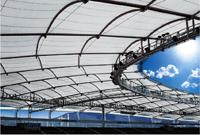Integration of Photovoltaics in Membrane Structures

Estimating the yield
Estimating the yield from a photovoltaic system that is incorporated in a membrane structure is a far more complex process than that for conventional photovoltaic modules. The reasons for this are as follows:
?LZAs the product of quite different architectural designs, the geometry of roof and facade structures will obviously vary from project to project and necessitate different layouts for the integral photovoltaic system in each case. In other words, a standard situation that would allow the development of a more or less uniform product scarcely exists.
?LZThe orientation of the inpidual photovoltaic elements in relation to the sun can vary within a single project. The process of determining the form of the films or membranes – the outcome of a building’s geometry, the supporting structure and the loads to be borne – will also be decisive for the geometry of the photovoltaic system.
?LZGenerally speaking, the surfaces should be curved in at least one direction – better still in two (anticlastic) – otherwise they will not be structurally stable.
?LZThe complex, three-dimensional forms that occur make it more difficult to assess possible shading effects.
Prof. Dr.-Ing. Jan Cremers is director of envelope technology at the Solar
Next AG/Hightex Group in Rimsting on Chiemsee, ¬Germany. He also teaches at Stuttgart University of Applied Sciences.
grated in large-area pneumatic structures. When the photovoltaic elements are used as an intermediate layer or inside a cushion, they are, of course, optimally protected. In such cases, however, the light-refracting effect of the upper film layer and the thermal gains that occur in the heat-absorbing middle layer would result in a diminution of the energy yield. For that reason, it is clearly preferable to integrate the photovoltaics in the outer layer of the cushion.
Although suspended building elements are ideally suited for large-area structures like stadium roofs and airports, there was hitherto no way of incorporating photovoltaics in them. With its PV Flexibles, SolarNext AG has now developed a form of photovoltaic technology that enables solar cells to be integrated directly into membrane materials.
This technology is based on extremely flexible, amorphous thin-film solar cells embedded in ETFE laminates. Durable building materials like ETFE film and PTFE-coated glass-fibre fabric from the fluoropolymer group are a well-tried solution in everyday practice. They are more durable than PVC membranes; they are resistant to UV-radiation; and their “self-cleansing” surfaces ensure good resistance to soiling.
PV Flexibles can, for example, be used for single-layer roofs and facades without an additional supporting structure. They can also be substituted for the upper layer of pneumatically supported cushions. Used on situations such as these, photovoltaic elements serve not only to generate electricity; they can also provide shade, which may often be an essential requirement.
In this way, insolation within the building in summer can be minimized, thereby reducing the necessary cooling loads and energy consumption. This synergetic effect is especially important, since it helps to improve the economics of the integrated photovoltaic installation.
The development of the thin-film technology used in this context took place at the University of Neuchâtel in Switzerland. In the meantime, it has undergone further refinement by the established Swiss company VHF Technologies, which also manufactures the resultant product. In a continuous (roll-to-roll) production process, the photovoltaic cells are applied to the polymer bearing material in a sequence of layers, whereby the solar cells ultimately have a total thickness of only about 1 µm.
